Sometime back I was asked about booklets or resources for th e Extraordinary Form of the Roman Rite for those who are, perhaps, first timers.
The nice people at Angelus Press sent me an example of the Extraordinary Form Mass booklet for use by people in the congregation who may not have their own hand missal.
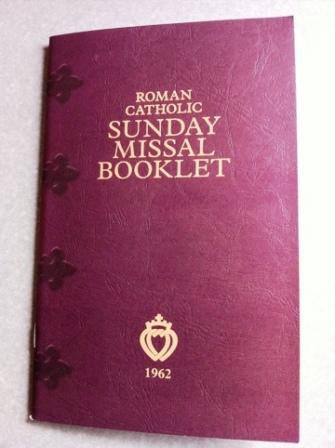
The booklet has a thin cardboard-like cover with a little texture.
This 2007 booklet is based on The Ideal Missal revised by Sylvester P. Jurgens, SM, of 1962, which had an imprimatur. Commentary was adapted from sources from 1908 and 1960. This particular booklet is a 2008 3rd printing.
It of course has the name of St. Joseph in the Canon.
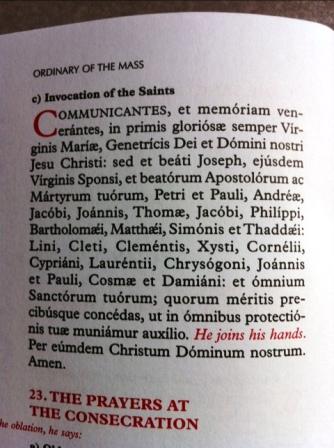
It is useful also in the UK.
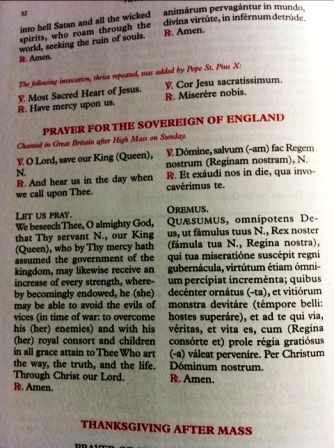
There are indications, within boxes, for Solemn Masses.
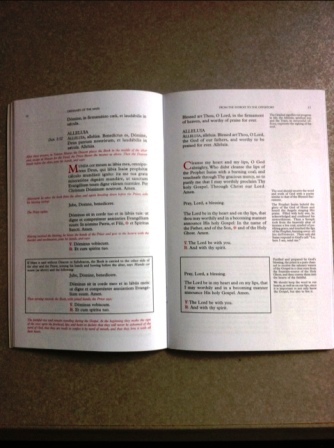
There are spiritual comments in the margins.
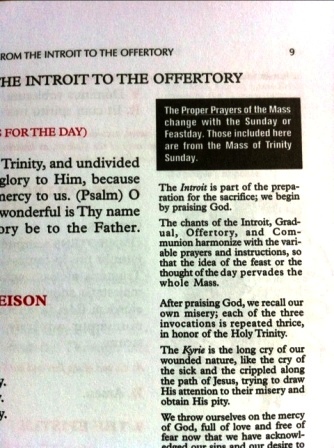
A sample of artwork.
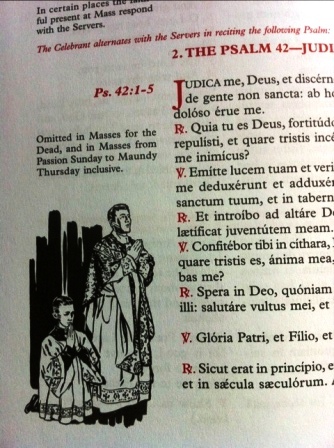
In the back there is an area to indicate the place where the booklet was obtained. Note: it says “Chapel contact information”, and not “Church contact information”. Perhaps this could be corrected in a future reprint. It would make it slightly more useful.
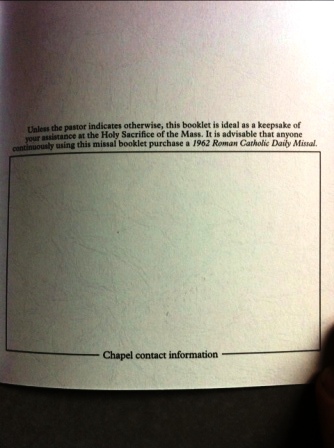
In the back of the booklet there are the “Leonine Prayers” once ordered by Leo XIII for after Low Masses, prayers for after Mass, Exposition and Benediction. There are no “catechetical appendices” as in the “red” booklet, which spurred the “Ask Father” question I mentioned at the top.


































I realise we have just had a royal wedding of the heir of the heir to the Throne, but I smiled at the default prayer in the missal: “Domine salvum fac regem nostrum… with salvAM… and Reginam as the alternative. In practice of course it is still “Domine, Salvam fac Reginam nostram Elizabeth” and has been since 1953. I think she may stagger on a little longer.
Incidentally, that prayer for the Queen (in this case Victoria) is inscribed around the face(s) of Big Ben by the Catholic architect Augustus Welby Pugin in the 19th century – one of the many Catholic signs and signatures that can be found in the Palace of Westminster if one knows where to look and how to read them.
I just read that Bishop Paprocki of Springfield – formerly a vicar of our Chicago archdiocese — has ordered that all parishes reinstitute the prayers to St. Michael authored by Pope Leo XIII to be said after the Masses throughout his diocese.
I just looked it up; only $3 each if you buy 10. At that price they can be given to visitors.
Thanks for posting this Father.
These are very attractive booklets at a very reasonable price also.
At $3/10, the price is much better than that of the “Red Missal”. This is a good alternative for smaller communities and those communities just getting started.
Does anybody have any leads to a quality alternative to the OCP misallettes? Or leads to a new pew missal for use after the November changes?
Was it typical of churches “in the old days” that they had nice missal booklets for visitors? Probably this is among the examples of ways the “Tridentine” Mass is being celebrated and presented with more care today than before? I know the booklets (maybe the “Red Missal” David Werling mentions?) are appreciated at my church’s Tridentine Mass.
My mom, still a Protestant today, met my Dad when the old Mass was still being celebrated and recounts not being able to make any sense out of it, apparently my Dad didn’t use a missal or share one with her. I LOVE my 1940 vest pocket size Fr Stedman missal, which I randomly got with a group of other books from eBay, which has traditionalier art than editions a year or two later, and is bound in genuine “American Seal Leather” (they don’t make em like they used to).
I was looking into buying one of these a few weeks ago. But I said nah, because I’d probably forget about it. But you’ve changed my mind. I think I may go for it, after all $3………
Also!!!! Remember this is especially useful in Canada as well because Her Majesty is the Head of State and Sovereign as well!
God Bless Father!
I’m still waiting for a pre-Bugnini, pre-1955 missal to be published anew.
It was asked: “Was it typical of churches “in the old days” that they had nice missal booklets for visitors?”
No, never in my experience. Everyone except the most insensible of children had their own hand missal. By the third grade at latest, children had a hard-bound inch-thick simplified (no Latin propers) missal for the complete year. At my school, the “St. Joseph” missal was most popular, but the “St. Andrews” missal had more Latin, so I chose that. I actually wanted the full version of the St. Andrews with Latin propers, but it was too expensive. If one did not on occasion have a personal missal, the constancy and regularity of the liturgy promoted such familiarity that one was never lost. Insentient congregations nibbling their liturgical pablum from a church-provided phone-directory-quality “missalette” is a post-Vatican II innovation.
It was suggested: “Probably this is among the examples of ways the “Tridentine” Mass is being celebrated and presented with more care today than before?”
Also not true.
Mike,
What you describe seems to me to be a big “then and now” difference in actual participation of the people in the liturgy.
In the parishes I attended in several states prior to the great leap forward, most of the people used missals and were familiar with the old Mass, recognizing the responses and ordinary parts in Latin. Now, most people don’t use missals and remain largely unfamiliar with the various parts of the Mass, even though they hear them Sunday after Sunday in the vernacular.
Elizabeth D wrote: ” I LOVE my 1940 vest pocket size Fr Stedman missal, … and is bound in genuine “American Seal Leather” (they don’t make em like they used to).” And for that fact the American Seals raise their voices in a big “alleluia” to our Creator, I am sure. :-)
I agree with Mike Morrow. Before my First Holy Communion in 1963, I was given several picture books and easy “first reader” books written for children to follow the Mass in pictures and simple words. Even these had a few Latin words in them. At First Communion we all received a hard cover missal with the Sunday Gospels and Ordinary of the Mass in English and Latin (no seals furry or Navy were harmed in the production of these, Deo Gratias). Before that First Communion Mass, we 7 and 8 year olds could all follow and respond in Latin to the major parts of the Mass.
Both my parents had Missals both a large Sunday one and a small pocket one. Those booklets at the end of pews came in with the Vat II changes. Hmm. All those paper booklets being thrown away every few months. Seems the old way – with covers sans the poor seals’ skins — was the more green way after all.
AvantiBev,
Bp. Paprocki has authorized the Prayer of St. Michael after Mass, not ordered.
See Fr. Z’s blog
Mike, if there had been booklets for visitors (someone who regularly attends should get their own missal), then my mom might not have found it so opaque when she was visiting at Mass as Protestant. My Dad presumably could have provided a missal and taught her about it, but he didn’t. And a non Catholic who just wandered into church wouldn’t have anything. Now non Catholics and also Catholics need something to help them and catechize them with the unfamiliar Latin Mass (at my church there is also a separate handout with propers and readings) and they are usually not going to already have their own Missal.
I was familiar with the Novus Ordo in Latin before attending a Tridentine Mass, this is probably an unusual situation but makes it easier to orient oneself. The Novus Ordo should definitely be celebrated more in Latin.
I notice that the brief explanation of the so-called “Prayers Ordered By the Pope” (or as I would rather call them, “Prayers Suppressed By the Pope”) to be recited after Low Mass indicates that Pius XI asked that the Leonine Prayers be said for the “conversion of Russia”…an enduring myth. I’m a little amused, too, by the reference to the British Monarch as “The Sovereign of England”. Is this Missal pre-Jacobean?
There is something about the use of drawings of a priest celebrating Mass that seems a smidge childish and I’ve never cared for missals so illustrated; I’m also not wild about the notes in the margins which are sentimental, at times, and which seem to attempt to impose the editor’s spiritual insights upon the user of the missal, for example (at the Offerimus tibi):
“The Priest bows down profoundly, overcome with confusion before his own weakness and the greatness of the sacrifice he is about to offer.”
It’s as though it were a matter of fact and rubrics that the priest, at this point, becomes “overcome with confusion”. But that’s just one example of many similar notes in the margins. I prefer a missal that simply tells me what the celebrant and the other ministers are reading or chanting or doing (the black and the red), not one that fictionalizes what the celebrant is feeling at any given moment, or which tells the worshipper what he should be experiencing, interiorly, every step of the way. That’s annoying.
Those criticisms notwithstanding (and I bear in mind that these booklets are designed primarily for Extraordinary Form neophytes), the booklet is handsomely printed, using both black and red ink, in an attractive font and layout. The English translation is suitably high and dignified, without being archaic. Those who don’t mind being told what to think or to experience interiorly may actually appreciate the marginal commentaries, and those who do mind will have no problem ignoring them because they’re unobtrusive.
I’m glad that there is prominently printed in the beginning of this missalette a quote from Pope St. Pius X encouraging Catholics to pray the Mass, and to “follow with eye, heart, and mouth all that happens at the altar,” a quote standing in stark contrast to the opinions of some who imagine that it is just as well to pray their rosary or a novena or any other private devotion during Mass.
Purchasers should be aware that the Angelus Press is the publishing arm of the Society of St. Pius X in the United States, and to buy their products means to financially support the SSPX and its activities. That having been said, I have no great qualms about buying from them, and I have found that their customer service reps are always very friendly and very helpful.
AvantiBev, I oppose a return to seal-harming missal manufacture. :-) It has an interesting Biblical connection though since the Book of Numbers says the sacred Tent with the Tabernacle was to be covered in sealskin, by order from God. The American Seal Leather of this missal is disintegrating so I am confused why the Lord would order it as roofing.
“You dolphins and all water creatures, bless the Lord” (Canticle of the Three Young Men, from Daniel)
There is one area in which I think the Angelus booklet is inferior to that put out by the Coalition in Support of Ecclesia Dei — it lacks the prayers before Mass such as the Prayer of St. Ambrose and the Prayer of St. Thomas Aquinas that one might use to prepare for Holy Mass and the reception of Holy Communion. (These are also generally found in handmissals as well.) In most or all other respects the Angelus Press booklet is superior, but when I go to Mass and don’t have a handmissal with me I reach for the red booklet first.